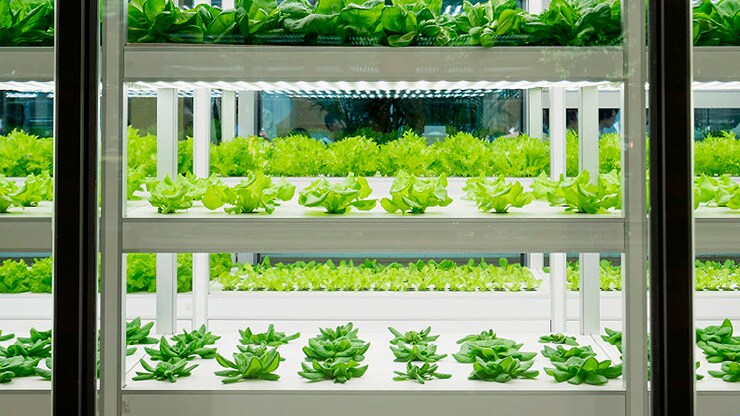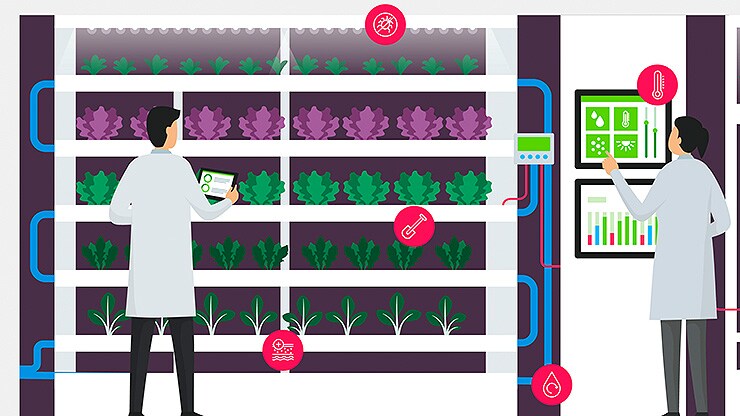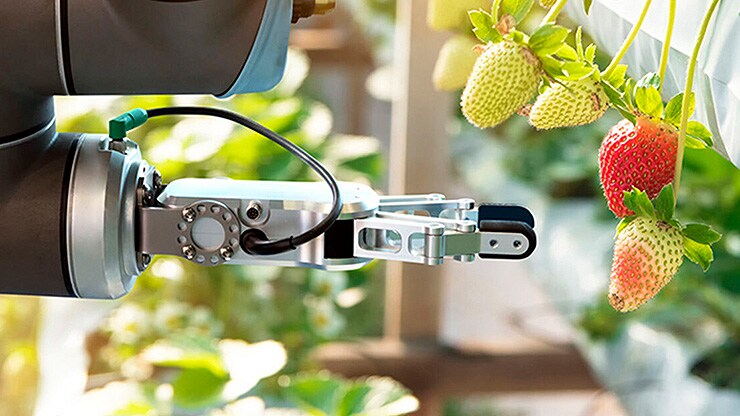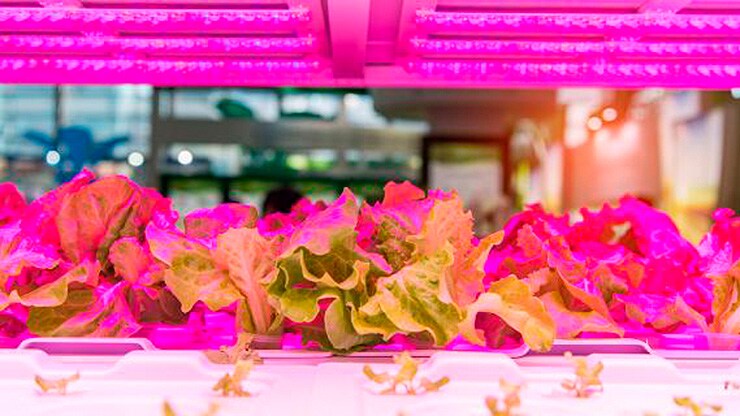What is needed for effective indoor agriculture?
A well designed indoor growing system has 3 core components.
A typical system that's well thought out and is designed for the most chance of success will have:
1) Expert Lighting:
"I can’t stress enough how much we’ve seen increases in crop productivity and the proper checks and balances in place for plant transpiration, canopy saturation of light, etc. So having really good lights in a system really makes a big difference, if you’re looking at having the most yield possible. So, good quality lights (is the first pillar)."
2) Controlled Atmosphere:
"A controlled environment is one that controls all ambient or external influences, so, literally cutting off the outside world, so everything from water, to airflow, and the actual air itself is recirculated within the system.
What that really permits for us is to have a constant, or consistent environment for the plants to grow up in. So an example would be today I’m just sitting on the east side of Toronto right now, in Ontario, it’s not too cold today but it has been very recently, about -20 degrees Celsius.
If we were using a containerized farming system or a shipping container farm, or even a modular farm that was using external air pulled into the system, it would be pulling that cold dry air, depending on the day, into the farm, which means the system always has to fluctuate, ebb and flow a lot.
That means increased cost for electricity as the system cycles through heat and cold, dehumidification, etc. but blocking the outside air means the farm is always a consistent 72 degrees or 74 degrees Fahrenheit in our instance. So controlled environment is very important, keeping out bugs, keeping the air temperature and the humidity exactly what they (the plants) need."
3) Growing Space:
"People will take this for granted a lot, especially in some of the tighter, condensed growing environments like shipping container farms, some of them are very well thought out, some of them try to pack too much stuff into very little space thinking that if you can just squeeze in an extra 500 plants it’ll make a difference.
The reality is, you get too tight in that space it restricts the airflow, it restricts proper dehumidification, it can cause mold and mildew issues.
You can’t really put in a high intensity lighting system if the plants are too close to the lights because it’ll burn the plants, there are a lot of advantages of having that extra bit of space.
Space is king for sure, in tight growing spaces, so, again, adequate space for the plants to grow, and for the environment to be treated properly, a controlled environment to begin with, and really good lights."
What are the best indoor grow lights?
"There’s a clear distinction to be made between somebody who wants to get their feet wet, so to speak, in urban agriculture, and that’s how I got started, I started tinkering, before we got our first shipping container farm, I bought a seedlings tray and a cheap LED light from Home Depot, and gave it a try.
So there’s a distinction to be made between somebody who wants to experience urban agriculture or just growing indoors, which could be in the living room or in the basement, versus somebody who wants to grow commercially, so if you’re starting on a small scale and just want to try it out, the reality is that the best solution is going to be the solution that’s within your budget, otherwise you’re not going to get started at all, so starting with a nice inexpensive T5 fluorescent light or T8 fluorescent light, I mean even if it’s something sitting in your shop, garage, or basement that you haven’t used for a while, it will still be a source of light for plants.
It might not be the best source of light for plants but it’s a source of light for plants. Same thing with scale, you don’t need to grow four thousand or five thousand plants at once, if it’s a trial and you just want to feed your family a little bit and experience maybe with ebb and flow or drip irrigation, it’s all about budget, so when we talk about enclosed environment or controlled atmosphere agriculture, the reality is that provides the optimal environment for the plant, so it allows us to control the relative humidity, air flow etc, the matter of the fact is that plants will grow in almost any environment, most of them are hearty enough, like kale, for example, mint, those things will grow in the cracks of a sidewalk , given the right conditions.
You don’t really need to really have high intensity LED lighting with the right spectrum , you don’t need high pressure sodium lights to grow kale and mint, for the first time, the reality is that it can be a joy and provide lots of health and benefits to your family if you just start on a very small scale with a very small budget, my advice is to just, get started.
Some considerations will be the expected outcomes too, are really important to discuss. Some people say, man look at all these videos online with these big plant factories or the big rooftop farms, or modular farms for example, and they grow these huge heads of lettuce and this fantastic abundance of kale, and it looks great, but then everyone’s at home at my dining room table, or in the basement in the corner, and I’m getting different effects, we’re getting kale that’s a little spindly, heads of lettuce, don’t look like they do in the grocery store. So as long as you have the right expectations starting out, and you know if you’re using a fluorescent instead of an LED or HPS, high pressure sodium light, that you’re going to get some apples to oranges comparison of the experience, then you won’t be disappointed."
LED Grow Lights For Indoor Plants
"Just to keep it as simple as possible when we’re referring to T5 and T8, we’re referring to the gauge and diameter of the fluorescent tube, primarily, without getting into all the tech specs about it, so a T8, would be what you would typically see in your office, or in your classroom, up above in the ceiling, that’s the standard diameter, typically a 4 foot length fluorescent light tube. T5 is essentially the same thing except smaller, typically the length is much smaller, or it can be smaller, as small as a foot or two feet, and the diameter is smaller, which of course effects the output potentially, etc, but we’re referring to fluorescent lights when we talk about T5 and T8, and then of course LED’s and high pressure sodiums.
The one recommendation that we always have when we’re talking about fluorescent vs LED, regardless of the quality of either of those lights, is to consider pets and children around those lighting solutions as well, so in classrooms for example, or at home if you have little ones running around, especially those that are just at the age where they like to grab things and test things out on their own, there are a lot of inherent benefits of LED lights in growing food of course, but there’s also a safety measure too, an LED light is much more difficult to break, depending on the design of it, but most of them are fairly durable, rugged, and can be knocked over, and picked back up and plugged back in, a T5 or T8 fluorescent light, most of them if not all of them have a mercury component in the lightand are considered hazardous materials if they break, so that’s certainly a consideration we make to all of our school clients, is to always consider an LED investment, because it can be a little bit more expensive, actually in most cases about twice as expensive as a fluorescent solution, but it’s worth it for safety reasons."
How to Select A Crop To Grow On Your Indoor Farm
"I would suggest that somebody grow whatever they want to grow, there’s no point in growing mint if you can’t stand it, because you’re not going to eat it and you’re not going to enjoy it, so that might deter you from proceeding, if you’re talking about simplicity, there’s a wealth of resources on the internet, I can’t even begin to scratch the surface of how much help there is on YouTube, obviously via Urban Vine, a lot of the collaborators and colleagues we participate in the industry with, there’s a lot of information out there, not only to help people decide what to grow but how to grow that crop.
I would say the most important thing is to be realistic, and those two matters or two principals: (1) one is grow something that you think you’ll enjoy eating, even if you’re head of lettuce isn’t huge like it is at the grocery store, or from a commercial hydroponic or aquaponic farm, the reality is that you’ll actually enjoy eating that romaine lettuce, even if it’s a little scraggly looking and the head is only half formed, at least you’ll be able to enjoy the fruits of your labor. (2) And the other one is the footprint of the plant as well, and the growth cycle, so, as an example, as a vegan, I eat a lot of quinoa, but I wouldn’t grow quinoa in my basement in a hydroponic set up, because the lifecycle and the footprint of the plant just don’t make sense. Just like corn too, you might say, well “man I’d really love myself a good cob of corn”, but growing corn in a seedling tray in your basement is not going to be the best idea, so be realistic about the lifecycle and the harvest cycle of the plant, and the physical size of the plant when it grows up.
Another good example would iceberg lettuce as well, a lot of us as North Americans consume iceberg lettuce, it’s not a bad thing, at least we’re eating some veggies, but the reality is that growing iceberg lettuce hydroponically is not the most effective plant, especially for beginners, the plant has a longer life cycle than a loose leaf lettuce like oak leaf or salad bowl or butter crunch or something or something of that nature, but the physical size of the plant if it was to grow properly is much larger, takes longer to harvest, so I think those would be the two considerations.
I wouldn’t recommend cucumber, as a start, fruiting plants, actually that’s another good point, fruiting plants are going to be a little more difficult as well, so strawberries, cucumbers, tomatoes, anything that develops a flower before it turns into a fruit or vegetable, is going to be more challenging.
Some plant varieties are self-pollinating, so we don’t need to worry about pollination so much, just air movement in the house, the dog walking by and wagging its tail is enough to pollinate some species of flowering plants, but you’d have to pick the specific breed or cultivar of plant to make sure you’re getting something that is self-pollinating, and most self-pollinating plants, or flowering fruit plants, will also mean that they’re going to be vine or creeping plants, which are going to be cumbersome to handle in a small system at home too, again, perfect example, the cucumber did fairly well in our farmwall, the vertical towers that I have in my living room, but the vines were literally growing across the floor, and wrapping around the lights and things like that, and things were difficult, so there’s a variety of reasons to not try fruiting plants at first, it will be less rewarding, almost assured, than it would be to just grow a simple head of lettuce or herb, or brassica of some sort."
Creating a Profitable Indoor Urban Farming Startup
"Technologies are starting to provide answers to profitability questions for urban farming companies at this point, the cost of LED lights, the cost of technology in general, the accessibility, so the advent of IOT the internet of things, and the ability to connect remotely with our devices and therefore our farms, to be able to monitor and remotely control aspects of those farming operations, small and large, are really helping with accessibility, so again the cost and connectivity of those technologies is really helping out, but there’s room for everybody to be honest with you.
While a very large commercial operation, like a warehouse farm, let’s say, 20,000 square feet in size, will obviously feed a larger community, the reality is that you can now get an awful lot of food out of a small containerized farm, or even a garage or basement f arm if it’s done properly and operated safely, to feed portions of a community, so the return on investment is now really related to the farming practices and the motivation.
So we don’t discourage anyone to get started at a hobby level for sure, but if we’re talking about transitioning from hobby to commercial, generating revenue and an ROI, it seems that most systems, if properly thought out, and that would include a look at the market the system is being deployed in as well, should provide an ROI in 3-5 years, which is within the expected range for new business startups, for successful business startups, so people shouldn’t expect to have an ROI in year 1, if someone is promising you that then be cautious of course, we’re seeing 3-5 years on average for the systems that we generate, sometimes it can be less if the crop that you’re growing is serving a particular market and has a very high value."
Examples of Profitable Indoor Urban Farming Niches
"Medicinal herbs, and I’m not referring to cannabis, I’m referring to more traditional Chinese medicines that are being explored in urban farms as well, an example from my perspective would be a niche client looking for a niche product all for themselves, so it could be as simple as kale, kale can generate a really good return in the right system, if you have a client that is willing to pay for it, a good example would be a client, a smoothie shop, and this is a real experience that I had about a year ago, I approached one of Canada’s larger smoothie franchises and introduced our product and our prices, they absolutely loved the product, but made it very clear that their core message was not, non GMO, local, organic, it was just cheap smoothies for the masses, so they had no interest, but their competitor, one of their competitors, was willing to pay the high value that they were seeking, because their core brand was, local, non-GMO, organic, sustainable, and they got it, it was marketing partnership for them, in essence, where the story was easy to tell and their customers were seeking those solutions at that brand and that banner.
So if you’re addressing the market properly and you’re starting on a small scale, as small as 200 or 400 square feet in a containerized f arming system or even in your, I don’t want to say home because I don’t people to think that they can just grow a commercial outfit out of their home, you can but it requires a lot of consideration for zoning and health and safety etc, but the opportunity to receive an ROI within 3 years is certainly realistic."





